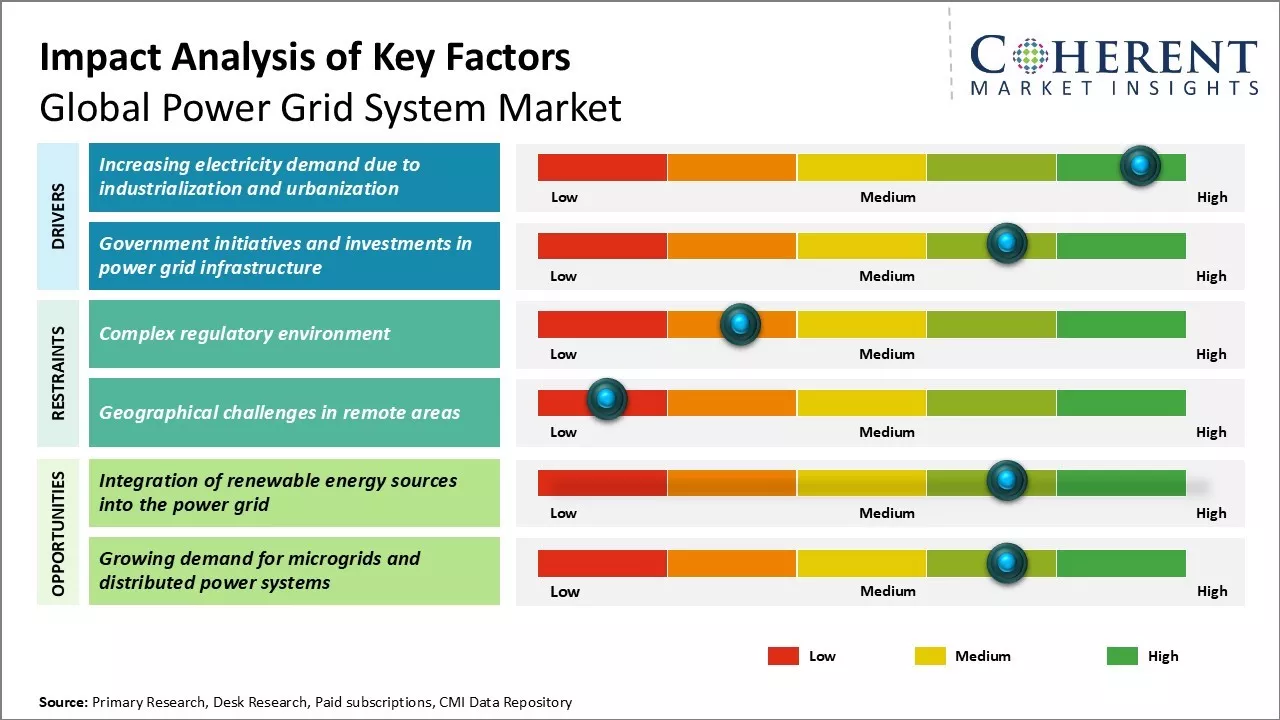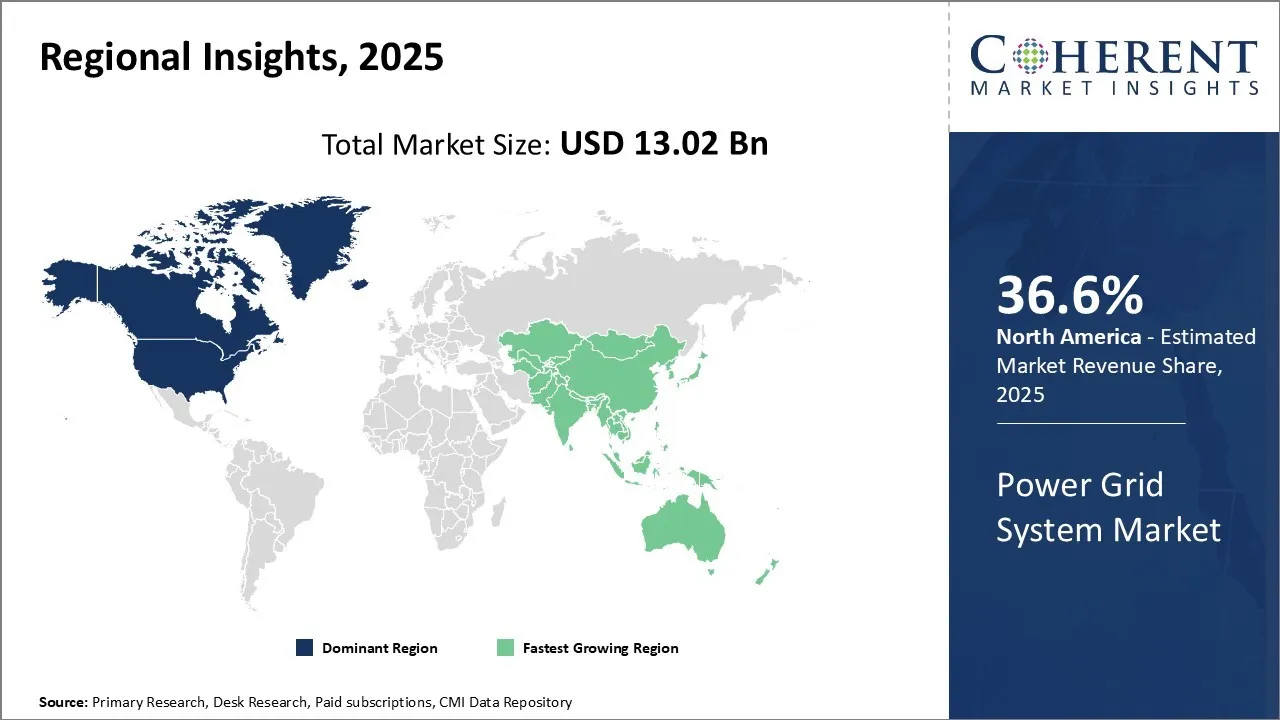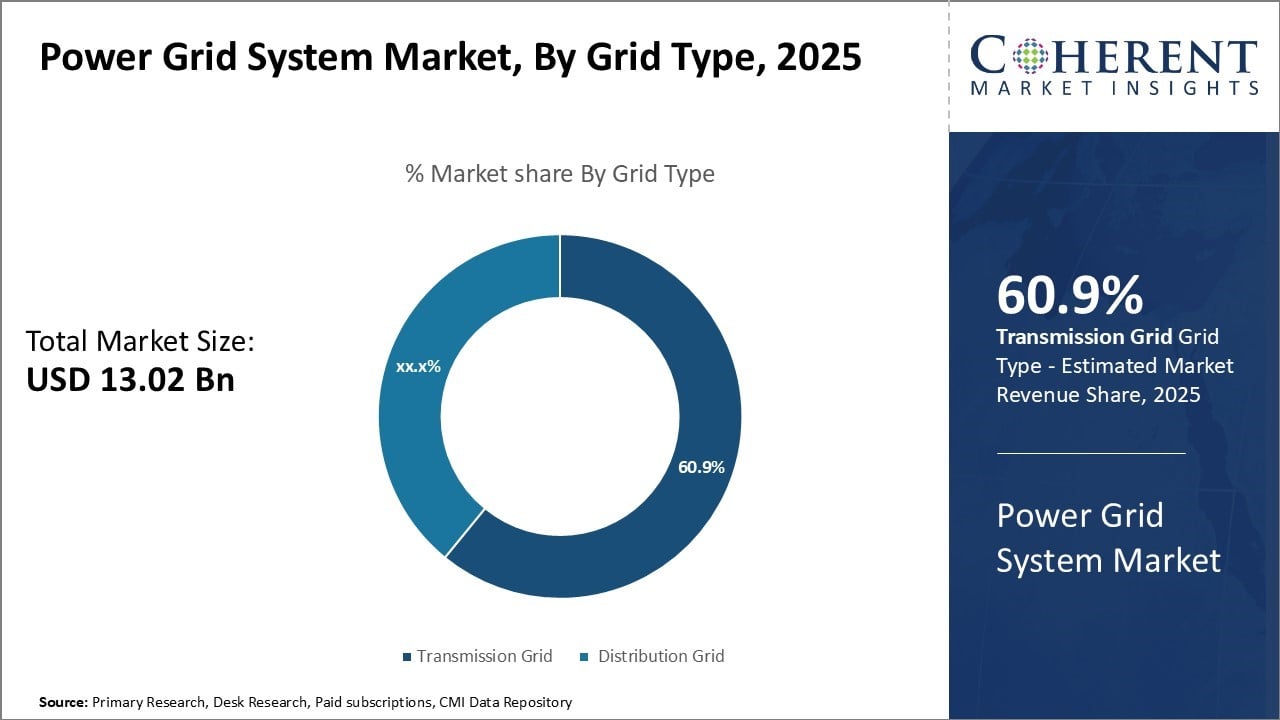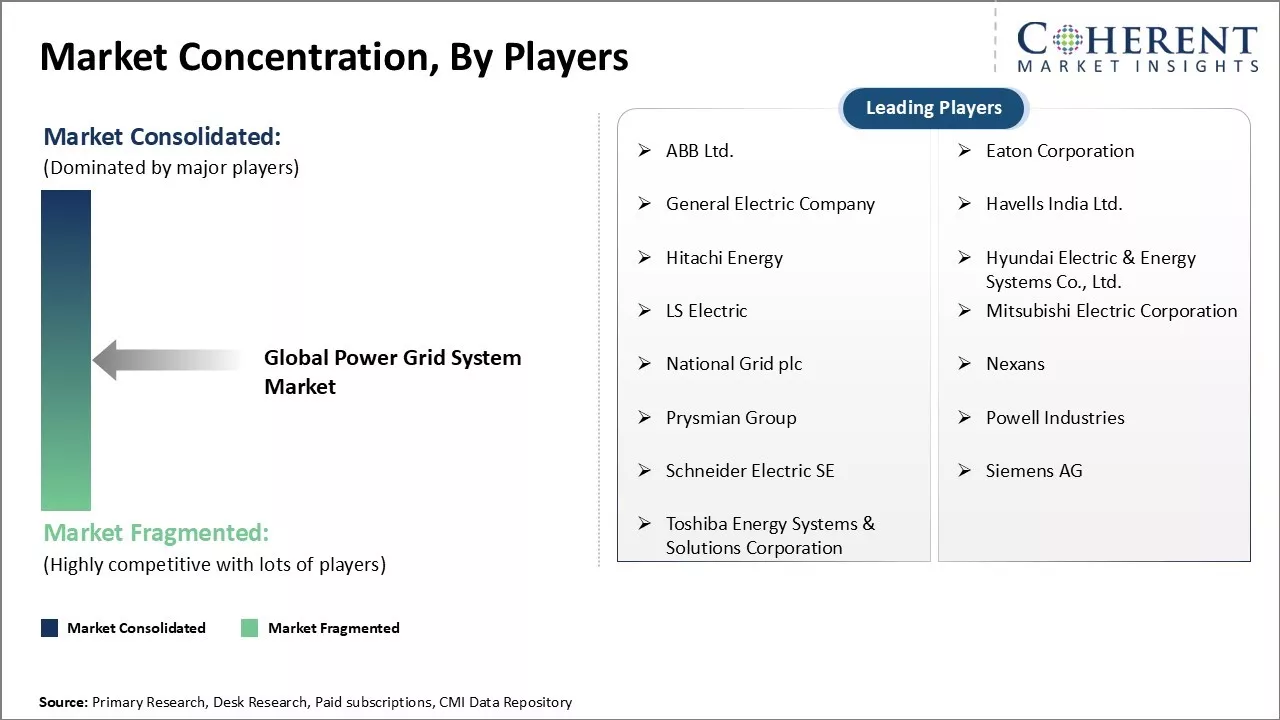Power Grid System Market Size and Forecast – 2025 to 2032
The Global Power Grid System Market is estimated to be valued at USD 13.02 Bn in 2025 and is expected to reach USD 28.10 Bn by 2032, exhibiting a compound annual growth rate (CAGR) of 11.6% from 2025 to 2032.

To learn more about this report, Download Free Sample
Key Takeaways
- Based on Grid Type, Transmission Grid acquired the prominent share of 60.9% in 2025 on account of rising transmission capacity and infrastructure.
- Based on Technology, Conventional Grid segment contributes the 54.8% share of the market in 2025 owing to the growing demand for load management.
- By End-User, Utility segment commands the 58.6% of global power grid system market share in 2025 as Consumer Demand and Engagement.
- By Region, North America as established itself as the dominant regional market for power grid systems with 36.6% share in 2025 owing to energy transition and renewable energy integration.
Market Overview
Factors such as increasing demand for clean and reliable energy and the deployment of smart grids along with the integration of renewables are providing opportunities for power grid system market growth. Governments and private players both are supporting the modernization of grids through investments. Also, demand for micro-grid solutions from industries and remote locations are surging.
Current Events and Its Impact
|
Current Events |
Description and its impact |
|
Macroeconomic Policy Shifts Reshaping Grid Priorities |
|
|
Critical Material Supply Chain Constraints |
|
|
Renewable Integration Challenges Reshaping Grid Architecture |
|
Uncover macros and micros vetted on 75+ parameters: Get instant access to report
Role of AI (Artificial Intelligence) in the Power Grid System Market
AI plays a transformative role in modern power grid systems by enhancing efficiency, reliability, and responsiveness. One key application is streamlining complex planning processes, such as connecting new generation resources to the grid. For instance, in April 2025, PJM announced a multiyear partnership with Google and Tapestry to implement AI-powered tools aimed at streamlining the planning process for connecting new generation resources to the nation’s largest electrical grid. This collaboration aims to drastically reduce processing times for interconnection applications, enabling faster and more accurate handling of high volumes of requests to meet the growing electricity demand across PJM’s service area, which includes 13 states and Washington, D.C.
End-user Feedback and Unmet Needs in the Power Grid System Market
End-user Feedback and Unmet Needs
- Electric Vehicle (EV) Integration & Charging Infrastructure: With the increasing number of electric vehicles (EVs), users report a lack of sufficient charging stations and grid capacity to support the growing demand. In urban and suburban areas, charging station accessibility remains a significant concern. There is a clear need for widespread charging infrastructure for electric vehicles and grid upgrades to accommodate increased demand.
- Grid Communication & Transparency: Many end-users report dissatisfaction with lack of communication from utility providers regarding grid maintenance, scheduled outages, or power restoration timelines. Consumers often feel uninformed about grid issues and need clearer, real-time updates. There is a strong demand for better communication systems that provide real-time outage alerts, maintenance notifications, and grid status updates.
- Decentralized Energy & Independence: Many consumers, especially in rural or remote areas, express a desire for greater energy independence through distributed energy resources (DERs) like solar panels, wind turbines, and microgrids. However, these systems are often too expensive or difficult to implement without significant support. There is an increasing demand for affordable, decentralized energy solutions that allow consumers to become self-sufficient.
Power Grid System Market Insights, by Grid Type - Transmission grid contributes the highest share of the market owing to its Investment and Financing
The Transmission Grid segment contributes the 60.9% share of the market in 2025 owing to several key factors. As economies develop and populations expand in regions across the globe, the demand for power grows exponentially. Transmission grids act as the vital arteries that enable the bulk transfer of electricity from power generation plants over long distances via high voltage power lines. They facilitate the consistent and uninterrupted flow of electricity to fuel industrial and commercial centers. Rapid urbanization also results in more concentrated pockets of electricity consumption that require extensive transmission networks to efficiently deliver and distribute power. Government initiatives to electrify rural areas further drive investments in transmission grid expansion.
In February 2025, Lithuania launched a €102 million ($105 million) energy storage procurement to secure balancing services for its transmission system operator and ensure grid stability.
Power Grid System Market Insights, by technology - Conventional grid contributes the Largest Power Grid Market Share owing to its Energy Security and Independence
The Conventional Grid segment contributes the 54.8% share of the market in 2025. These grids are primarily based on centralized, one-way electricity flows from fossil fuel or nuclear power plants to end users. Their dominance is driven by established infrastructure, reliability, and the ongoing need to support industrial and urban electricity demands. Smart grids leverage digital technologies like sensors, communications, and data analytics to modernize aging grid infrastructures. They enhance observability and control across transmission and distribution networks. Two-way communication enables better demand response capabilities and loss detection. This is further accelerating the power grid system market revenue.
Power Grid System Market Insights, by End-User - Utility contributes the highest share of the market owing to its Energy Transition and Renewable Energy Integration
The Utility segment commands the 58.6% share of the global power grid system market in 2025. Power generation, transmission, and distribution utilities rely extensively on robust grid infrastructures as the backbone for their core operations. Uninterrupted electricity supply across vast customer bases is crucial for maintaining consumer trust and ensuring regulatory compliance. Utilities also have enormous fixed asset investments in transmission assets like pylons and cables that require ongoing maintenance and life cycle replacements. Grid hardening measures gain significance in the face of increasingly frequent natural disasters too. With utilities accounting for the bulk of electricity consumption worldwide, grid reliability remains a top priority to minimize losses and disruptions across vast service territories. This cements the utility segment’s prominence in power grid industry.
In May 2025, the Texas Reliability Coalition (TRC) introduced an educational outreach initiative today to inform the public and elected officials about Utility-Scale Microgrid (USM) technologies. This public-private coalition aims to enhance the Texas electric grid’s resilience and reliability during extreme weather, improve daily system performance, and support the integration of renewable and intermittent energy sources.
Regional Insights

To learn more about this report, Download Free Sample
North America Power Grid System Market Trends
The North American power grid system market is modernizing as utilities increasingly adopt renewable energy, smart grid technologies, and energy storage solutions. They are integrating solar and wind energy, which requires advanced grid management tools to address intermittency. Utilities invest in smart grids and digital technologies for real-time monitoring and predictive analytics. Additionally, the groing penetration to generate affordable electricity is acting as one of the major growth inducing factor.
For Instance, in August 2024, the Ontario government initiated the largest competitive energy procurement in the province’s history to generate affordable electricity for families and businesses. This effort supports the province’s plan to secure up to 5,000 megawatts (MW) of energy through multiple procurements, aiming to promote economic growth and meet the rising demand for clean, reliable power.
Asia Pacific Power Grid System Market Trends
High population growth and industrialization are driving greater energy consumption, which in turn demands upgrades in grid capacity. Countries like China, India, and Australia are expanding their renewable energy capacity, which requires modernizing the grid to handle intermittent sources effectively. The adoption of smart grids is rapidly increasing, allowing for real-time monitoring, predictive analytics, and more efficient grid management. Additionally, the growing need for energy storage systems, such as batteries, is helping stabilize power grids, particularly for balancing renewable energy generation. In May 2025, Karnataka Renewable Energy Development Ltd (KREDL) invited bids for a 250 MW solar PV project paired with a 250 MW/1,100 MWh battery energy storage system at Ryapte, Karnataka. The project, to be developed on a build-own-operate (BOO) basis, aims to supply peak power and enhance grid utilization at Pavagada Solar Park.
Canada Power Grid System Market Trends
Smart meters and digital infrastructure enable utilities to optimize operations and integrate distributed energy resources (DERs). The demand for energy storage technologies, like battery energy storage systems (BESS), is rising to balance supply and demand, particularly with the growth of intermittent renewable energy. Energy storage also plays a crucial role in enhancing grid resilience during extreme weather events and emergencies. The increasing adoption of electric vehicles (EVs) is driving higher demand for charging infrastructure and greater grid capacity. In February 2025, Kempower partnered with Quebec’s Eastern Townships School Board (ETSB) and charging solutions provider Bornes Quebec to launch an innovative EV charging system.
China Power Grid System Market Trends
China is investing heavily in smart grid technologies to enable real-time monitoring, predictive analytics, and automated grid management. The government is driving the deployment of advanced metering infrastructure (AMI) and sensor networks to boost grid efficiency and reliability. Energy storage technologies, especially battery energy storage systems (BESS), are being increasingly deployed to stabilize the grid and store excess renewable energy. The growing presence of distributed energy resources (DERs), such as rooftop solar, small-scale wind projects, and microgrids, is transforming the power grid in China. In June 2025, China unveiled Qihang, the world’s largest floating wind turbine, featuring an 853-foot rotor diameter. Such projects are proliferating the power grid system market revenue.
Power Grid System Market News
- In June 2025, China Southern Power Grid commissioned the Baochi Energy Storage Station in Wenshan, Yunnan—a national pilot and China’s first large-scale hybrid lithium-sodium battery storage facility.
- In May 2025, POWERGRID Northern Region-II inaugurated the Swachhata Pakhwada 2025 campaign at its Regional Headquarters located in Jammu.
- In April 2025, Tigo Energy, Inc., a leader in intelligent solar and energy software solutions, launched its new High-Performance Off-Grid Solar Project.
- In February 2025, Ofgem announced a new fast-track connectivity method to accelerate connections to the national energy grid. This new approach will replace the current first-come, first-served system, which has caused long wait times for projects seeking grid access.
- In June 2024, the Energy Market Authority (EMA) has launched its upgraded Energy Management System (EMS II), equipping it with advanced tools and capabilities to enhance the monitoring and control of Singapore’s electricity transmission network, power plants, and natural gas transmission network.
Market Report Scope
Power Grid System Market Report Coverage
| Report Coverage | Details | ||
|---|---|---|---|
| Base Year: | 2024 | Market Size in 2025: | USD 13.02 Bn |
| Historical Data for: | 2020 To 2024 | Forecast Period: | 2025 To 2032 |
| Forecast Period 2025 to 2032 CAGR: | 11.6% | 2032 Value Projection: | USD 28.10 Bn |
| Geographies covered: |
|
||
| Segments covered: |
|
||
| Companies covered: |
ABB Ltd., Eaton Corporation, General Electric Company, Havells India Ltd., Hitachi Energy, Hyundai Electric & Energy Systems Co., Ltd., LS Electric, Mitsubishi Electric Corporation, National Grid plc, Nexans, Prysmian Group, Powell Industries, Schneider Electric SE, Siemens AG, and Toshiba Energy Systems & Solutions Corporation |
||
| Growth Drivers: |
|
||
| Restraints & Challenges: |
|
||
Uncover macros and micros vetted on 75+ parameters: Get instant access to report
Power Grid System Market Trend
Integration of Renewable Energy Sources
The global power grid system market is witnessing an increasing trend toward the integration of renewable energy sources like solar, wind, and hydropower. As countries set ambitious climate goals and prioritize green energy, grids are being modernized to handle intermittent power generation from these sources. The need for advanced grid management tools, such as smart grids and energy storage systems, is growing to ensure the smooth integration and stability of renewable energy.
Growing Demand for Energy Storage Solutions
The growing demand for energy storage is a key trend in the power grid system market. Energy storage technologies like battery energy storage systems (BESS) are crucial for balancing supply and demand, especially with the increase in renewable energy sources that can be variable. These systems store excess energy produced during peak production periods and release it when demand is high or renewable energy generation is low.
Power Grid System Market opportunity
Integration of renewable energy sources into the power grid
The global commitment towards addressing climate change and transitioning to renewable energy presents a major opportunity for the power grid system market. As the share of solar and wind power increases significantly in the coming decades, grid operators can play a pivotal role in facilitating this shift. Upgrading transmission networks to accommodate two-way power flows from renewable energy plants will be a key priority. Investing in renewable integration solutions like utility-scale battery storage and modern monitoring technologies will help ensure the stability and reliability of national grids. This opens up a large market for grid modernization projects, allowing companies to leverage their expertise.
Analyst Opinion (Expert Opinion)
- The evolution of the power grid system is at a critical inflection point, driven primarily by the accelerating integration of renewable energy sources and the urgent need for grid resilience amidst climate-induced disruptions. From my perspective, the most transformative dynamic shaping the sector is the increasing deployment of smart grid technologies, which are not just incremental upgrades but foundational shifts in grid architecture.
- For instance, the surge in Advanced Metering Infrastructure (AMI) adoption—by the end of 2024, more than 90 million smart meters have been installed in the U.S. alone, reflecting utilities’ strategic prioritization of granular, real-time data collection. This data availability is pivotal for demand response programs that have demonstrated up to a 15% peak load reduction in pilot projects like those led by Southern California Edison. These operational efficiencies translate directly into deferred infrastructure investments and improved grid stability.
- Moreover, the integration challenge posed by distributed energy resources (DERs) cannot be overstated. The penetration of rooftop solar in California has reached approximately 22% of residential customers, creating a two-way power flow scenario that traditional grids were never designed to handle. Utilities that are slow to adopt dynamic grid management tools and grid-edge technologies will face escalating curtailment costs and voltage instability. Conversely, early adopters of advanced Distribution Management Systems (DMS) — exemplified by Con Edison’s digital grid initiatives — are setting new benchmarks in operational agility and outage reduction.
- Critically, cybersecurity remains an under-addressed risk vector within the industry. As power grids become increasingly digitized and interconnected, the attack surface expands exponentially. The Colonial Pipeline ransomware attack in 2021 was a wake-up call, underscoring that grid operators must allocate a disproportionate share of their capex toward cybersecurity frameworks and threat intelligence integration. Neglecting this will not only jeopardize grid reliability but also invite regulatory penalties and erode public trust.
Market Segmentation
- Grid Type Insights (Revenue, USD Bn, 2020 - 2032)
- Transmission Grid
- Distribution Grid
- Technology Insights (Revenue, USD Bn, 2020 - 2032)
- Conventional Grid
- Smart Grid
- End User Insights (Revenue, USD Bn, 2020 - 2032)
- Utility
- Industrial
- Commercial
- Residential
- Regional Insights (Revenue, USD Bn 2020 - 2032)
- North America
- U.S.
- Canada
- Latin America
- Brazil
- Argentina
- Mexico
- Rest of Latin America
- Europe
- Germany
- U.K.
- Spain
- France
- Italy
- Russia
- Rest of Europe
- Asia Pacific
- China
- India
- Japan
- Australia
- South Korea
- ASEAN
- Rest of Asia Pacific
- Middle East
- GCC Countries
- Israel
- Rest of Middle East
- Africa
- South Africa
- North Africa
- Central Africa
- North America
- Key Players Insights
- ABB Ltd.
- Eaton Corporation
- General Electric Company
- Havells India Ltd.
- Hitachi Energy
- Hyundai Electric & Energy Systems Co., Ltd.
- LS Electric
- Mitsubishi Electric Corporation
- National Grid plc
- Nexans
- Prysmian Group
- Powell Industries
- Schneider Electric SE
- Siemens AG
- Toshiba Energy Systems & Solutions Corporation
Sources
Primary Research Interviews
- Interviews with industry experts and executives from utilities, energy companies, and grid operators.
- Discussions with engineers and project managers involved in grid modernization and energy transition projects.
- Conversations with regulatory bodies and policymakers regarding energy infrastructure and grid standards.
Databases
- International Energy Agency (IEA)
- U.S. Energy Information Administration (EIA)
- World Bank Energy Data
- European Network of Transmission System Operators for Electricity (ENTSO-E)
Magazines
- Power Grid International
- Energy Source
- Electric Power & Energy Industry
- Renewable Energy World
- Utility Dive
Journals
- IEEE Transactions on Power Systems
- Journal of Electrical Engineering & Technology
- Renewable and Sustainable Energy Reviews
- Energy Policy Journal
- Energy Economics
Newspapers
- The Wall Street Journal
- The Financial Times
- The New York Times – Energy Section
- The Guardian – Climate Change and Energy
- The Washington Post – Energy Policy News
Associations
- International Electrotechnical Commission (IEC)
- Institute of Electrical and Electronics Engineers (IEEE)
- American Society of Civil Engineers (ASCE)
- Renewable Energy Association (REA)
- World Energy Council (WEC)
Public Domain Sources
- U.S. Department of Energy (DOE) – Publications, Reports, and Data
- National Renewable Energy Laboratory (NREL) – Research and Publications
- European Commission – Energy Policy & Reports
- International Renewable Energy Agency (IRENA) – Public Reports and Data
- National Grid (UK) Annual Reports
- U.S. Federal Energy Regulatory Commission (FERC) Reports
Proprietary Elements
- CMI Data Analytics Tool, and Proprietary CMI Existing Repository of information for last 8 years
Share
Share
About Author
Sakshi Suryawanshi is a Research Consultant with 6 years of extensive experience in market research and consulting. She is proficient in market estimation, competitive analysis, and patent analysis. Sakshi excels in identifying market trends and evaluating competitive landscapes to provide actionable insights that drive strategic decision-making. Her expertise helps businesses navigate complex market dynamics and achieve their objectives effectively.
Missing comfort of reading report in your local language? Find your preferred language :
Transform your Strategy with Exclusive Trending Reports :
Frequently Asked Questions
EXISTING CLIENTELE
Joining thousands of companies around the world committed to making the Excellent Business Solutions.
View All Our Clients


